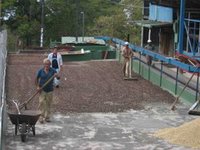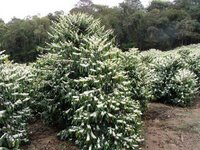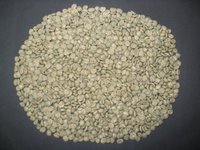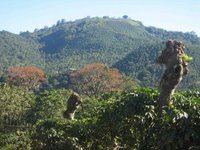Processing
| Much processing and human labour is required before coffee berries and its seed can be processed into roasted coffee with which most Western consumers are familiar. Picking Coffee berries are most commonly picked by hand by labourers who receive payment by the basketful. As of 2003, payment per basket is between US$2.00 to $10 with the overwhelming majority of the labourers receiving payment at the lower end. An experienced coffee picker can collect up to 6-7 baskets a day. Depending on the grower, coffee pickers are sometimes specifically instructed to not pick green coffee berries since the seeds in the berries are not fully formed or mature. This discernment typically only occurs with growers who harvest for higher end/specialty coffee where the pickers are paid better for their labour. Mixes of green and red berries, or just green berries, are used to produce cheaper mass consumer coffee beans, which are characterized by a displeasingly bitter/astringent flavour and a sharp greenish odour. Red berries, with its higher aromatic oil and lower organic acid content are more fragrant, smooth, and mellow. As such coffee picking is one of the most important stages in coffee production, and is the chief determinant for the quality of the end product. Defruiting The coffee berries are a type of drupe, with fruit flesh directly covering the coffee bean. For "washed" coffees, after harvesting, the flesh of the coffee berry must be quickly removed by soaking, scouring and/or mechanical rubbing. The defruited coffee bean is flushed with water to remove clinging fruit and additional sugars before drying. These coffees tend to rest in water (the "ferment" stage) for a set amount of time (depending on the origin and producer). Washed coffees tend to be described as "clean" and "bright." Coffees called "naturals" are those where the fruit is not immediately removed from the beans, but is instead allowed to dry and partially ferment. This creates a unique flavour profile with reduced acidity and increased body, though if done poorly can lead to lower quality beans. Other coffee processing methods include the Pulped Natural process, the Indonesian "semi-washed" methods as well as aguapulping and re-fermentation. Each produces its own flavour profile and each is, in essence, a different way of handling the process of defruiting the beans. Drying Coffee beans are spread over a large concrete or rock surface where they are dried by air and sunlight. The beans are repeatedly raked into rows and spread out over the course of several days until they are largely dry. At this stage, the beans are referred to as "green coffee".  Traditional coffee-drying in Boquete, Panama Sorting  Hand sorting of coffee beans in Salento, Colombia Roasting Unroasted coffee beans at later stages. The beans are 7 and 8 years old. Photos taken at Toko Aroma in Bandung, Indonesia. An old large-capacity coffee roaster made from cast iron. It is wood fired, and is located at Toko Aroma, Bandung, Indonesia
Roasted coffee beans At lighter roasts, the bean will exhibit more of its "terroir" —the flavors created in the bean by the soil and weather conditions in the location where it was grown. Coffee beans from famous regions like Java and Kenya are usually roasted lightly so their signature characteristics dominate the flavor. A roasting method native to the Ipoh town in Malaysia involves the inclusion of margarine (palm oil-derived) and sugar during the roasting process, producing a variety of roast known as the Ipoh "white" coffee. As the beans darken to a deep brown, the origin flavors of the bean are eclipsed by the flavors created by the roasting process itself. At darker roasts, the "roast flavor" is so dominant that it can be difficult to distinguish the origin of the beans used in the roast. These roasts are sold by the degree of roast, ranging from "Vienna Roast" to "French Roast" and beyond. The dividing line between extremely dark roast and "burnt" is a matter of some debate. Contrary to popular belief, the darker roasts and more strongly flavored coffees do not deliver any more caffeine than lighter roasts. In the United States, major national coffee suppliers tailor their product to tastes in particular regions of the country; for instance, a can of ground coffee purchased in the northeast or northwest will contain a darker roast than an identically appearing can purchased in the central United States. In the 19th century coffee was usually bought in the form of green beans and roasted in a frying pan. This form of roasting requires much skill to do well, and fell out of favor when vacuum sealing of pre-roasted coffee became possible. Today homeroasting is becoming popular again. Computerized drum roasters are available which simplify homeroasting, and some home roasters will simply roast in an oven or in air popcorn makers. Because coffee emits CO2 for days after it is roasted, one must allow the coffee to degas before it can be packaged in sealed containers. For this reason, many roasters who package whole beans immediately after roasting do so in bags with one-way valves, allowing the CO2 to escape but nothing in. This CO2 also affects the flavor of the brewed coffee, and most experts recommend a two- to five-day "resting" period post-roast for the CO2 to sufficiently escape. Once roasted, the volatile compounds that give coffee its complex flavors dissipate quickly. Despite the varying claims of "what is fresh" when it comes to coffee, the industry leaders in specialty coffee generally agree that roasted coffee should be ground and brewed no more than about 14 days off-the-roast. Some companies have tried to extend the freshness using a nitrogen-infusion system that flushes the inert gas into the roasted coffee, replacing the oxygen, ostensibly reducing oxidation. However, as is said in the coffee industry, "the proof is in the cup." |









